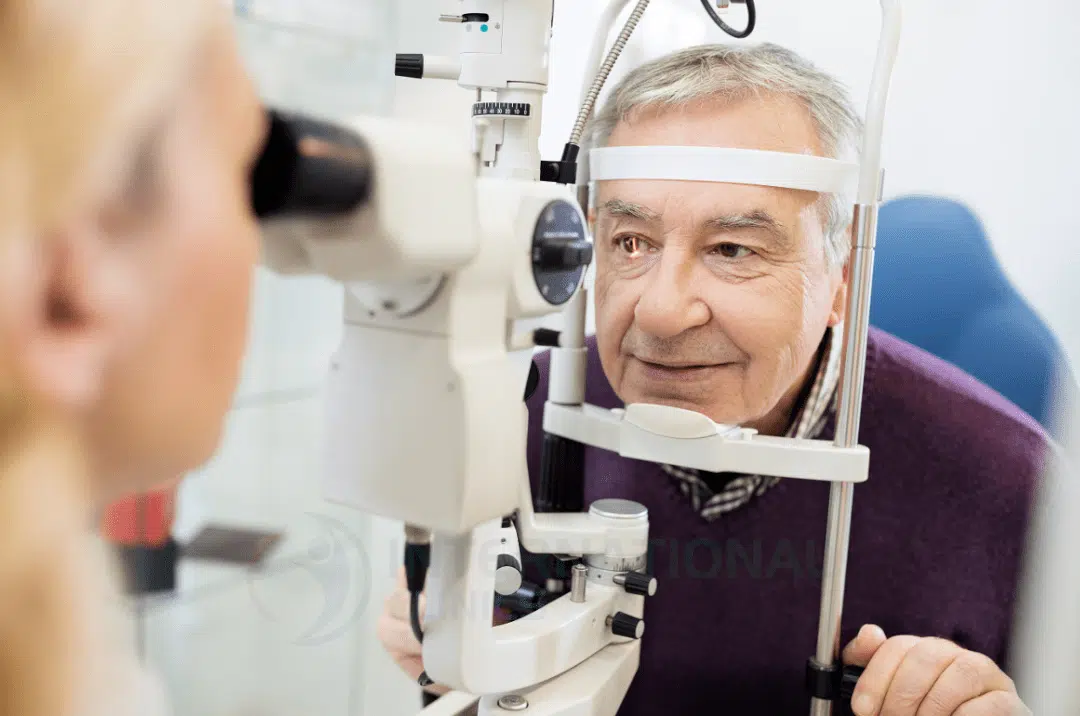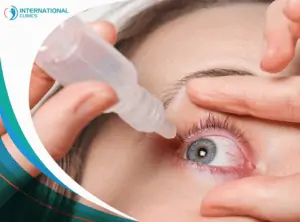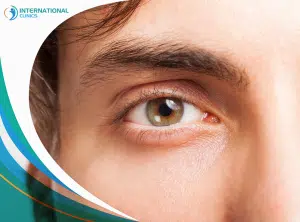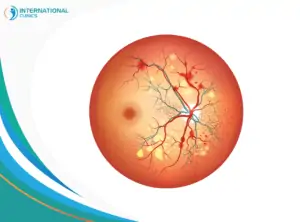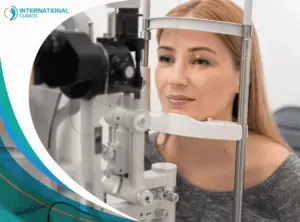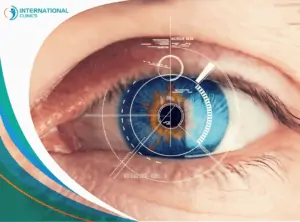Colors are what give things their unique nature and definitive distinctions that make them recognizable. This makes color blindness an unfortunate issue that requires attention and awareness. However, what are the three types of color blindness? Let’s find out!
Seeing colors with all their vibrance is a pleasurable experience. Shining and vibrant colors are also one of the components of eternal paradise according to many spiritual sects. Color blindness has nothing to do with high eye pressure.
In addition, the treatment of color blindness is difficult because the condition is caused by genetic factors. Hence, LASIK and eye surgeries can fix color blindness. Gene therapy has not yet gained a lot of attention among people. However, there are ways to coexist and adapt to it.
What Is Color Blindness?
Color blindness is a condition in which people cannot distinguish between some colors and others. This condition can affect both men and women, but the incidence is much greater in men than in women. According to studies, one out of every twelve men has color blindness. Meanwhile, it appears only in one woman out of two hundred.
As for the nature of color blindness, it is primarily a genetic condition that moves from one generation to another. It can appear in the grandfathers and the grandsons but not in fathers. Men and women can carry the genes of the condition without showing any symptoms.
The reason why it is more common in males than in females is that males carry one X chromosome, which makes the presence of one gene from one parent sufficient to cause the disease. Females carry two X chromosomes, so for this condition to be transmitted to her, the disease must have affected her mother and father together.
What Are the Three Types of Color Blindness?
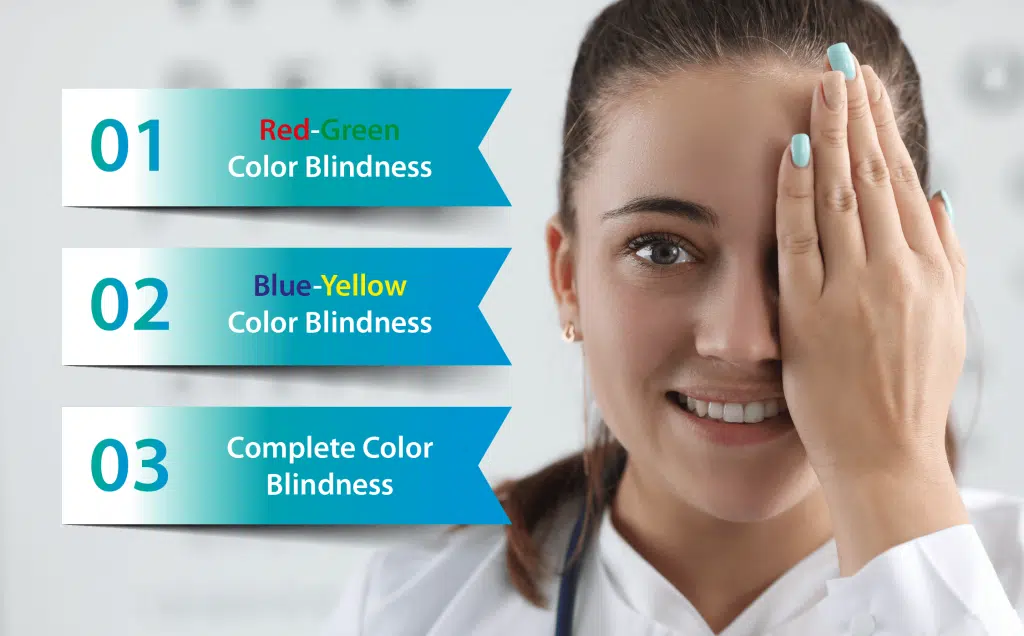
People who ask “What are the three types of color blindness?” are usually looking for the main types below:
Type No.1: Red-Green Color Blindness
Red-green color blindness is the most common type of color blindness among people. When you have this type, you’re unable to distinguish between red and green. This is not a standalone type; indeed, there are 4 types of red-green color blindness, including:
- Deuteranomaly: If you’re having this type, you will see green objects look redder. Studies have shown that this type is in fact the most common type of red-green color blindness, and fortunately, it’s not severe and doesn’t affect daily life activities.
- Protanomaly: If you’re having this type, you will see red objects look greener and less bright. Luckily, this type is also not severe and doesn’t affect daily life activities.
- Protanopia: If you’re having this type, you will be more likely to lose your perception of red light and confuse black with red and other colors. Mild protanopia colorblindness allows you to perceive too much green light, but little red.
- Deuteranopia: If you’re having this type, you will be more likely to confuse lose your perception of red light too and confuse other colors.
Type No.2: Blue-Yellow Color Blindness
Obviously, if you’re having this type, you will be unable to distinguish between blue and green and yellow and red. The spread of this type is limited among people, and it divides into two main types:
- Tritanomaly: If you’re having this type, you’ll be unable to distinguish between yellow and red, and between blue and green.
- Tritanopia: If you’re having this type, you’ll see colors look less bright and be unable to distinguish between yellow and pink, blue and green, and purple and red.
Type No.3: Complete Color Blindness
Complete color blindness is also known as “monochromacy”. People with complete color blindness can’t see or distinguish any color. Some cases also suffer from light sensitivity.
The Causes of Color Blindness
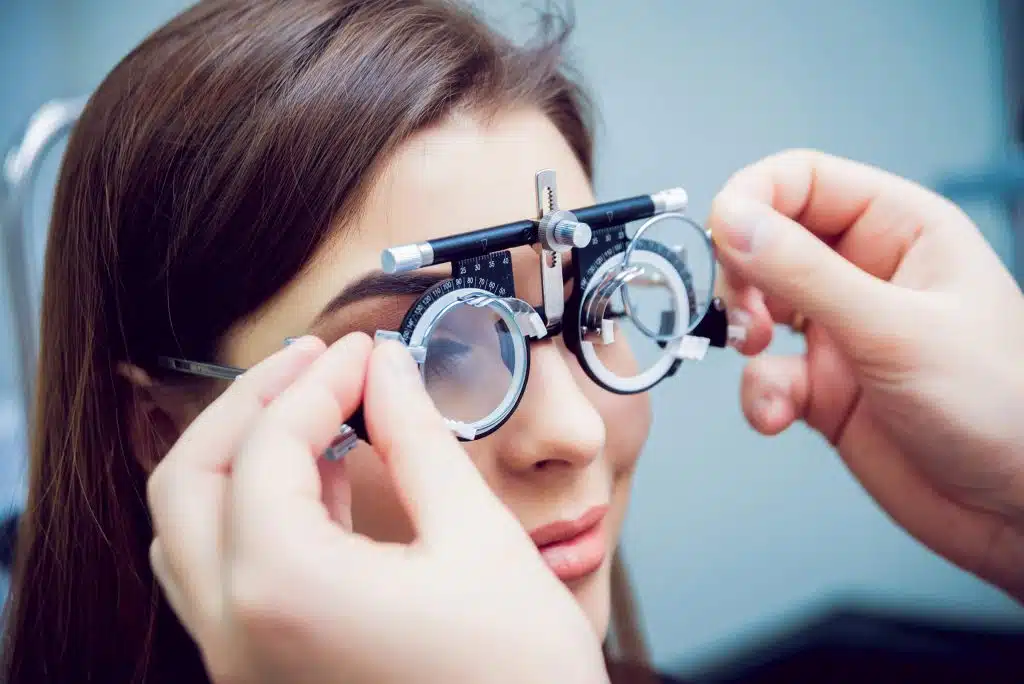
Now, after answering “What are the three types of color blindness?”, it’s time now to speak about the causes of color blindness:
- Genetics: the genetic factor is the main and most prevalent cause of color blindness. The condition is commonly transmitted from parents to children at birth. A healthy person has three types of cone cells in their eye (photoreceptors). Each type receives a different color from the three basic colors (blue, green, and red).
If the child is born with genes of the condition, they will be missing one of the types of cone cells. This results in losing the ability to see one of the basic colors or seeing the color at different levels than normal. - Other causes: According to reliable sources, around 3% of the population could develop color blindness because of aging. Other causes of acquired color vision deficiency include external eye injury, exposure to some toxic chemicals, certain medications, diabetes, macular degeneration, cataracts, and other diseases, such as:
- Parkinson’s disease: This is a neurological disorder that causes damage to light-sensitive nerve cells, making them unable to differentiate between colors.
- Leber hereditary optic neuropathy (LHON): This affects your ability to distinguish between green and red colors. It affects men more than women.
- Kallmann syndrome: This results from a problem in the pituitary gland. Color blindness is one of its symptoms.
What Are the Symptoms of Color Blindness?
There is a noticeable variation in the symptoms of color blindness. It is possible for a patient to see some colors, and at the same time not see other colors.
For example, The patient could differentiate between blue and yellow colors, and at the same time, cannot differentiate between green and red colors.
It’s possible for the patient to see many colors without knowing that they perceive them differently. Some colorblind patients cannot see the shades of colors and differentiate between them, while healthy eyes can see hundreds of shades of these colors.
The third type of color blindness (complete color blindness) can make the patient unable to see all colors except black, white, or gray. This remains rare, however.
How to Test Color Blindness?
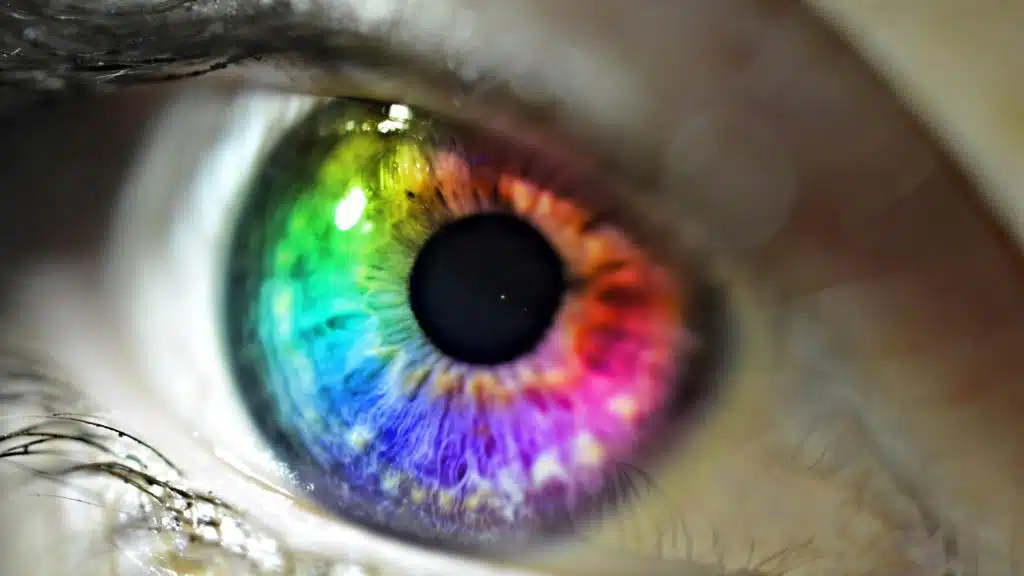
Color blindness tests don’t cause any pain of any kind, but the patient must cooperate with the doctor. Of course, it’s very challenging to test color blindness in infants. Besides, conventional examinations such as ophthalmoscopy can’t diagnose color blindness. However, there are several types of color blindness tests that doctors use to screen patients and determine the type of color blindness they have. Below are some of these tests:
Ishihara Color Blindness Test
In this test, the patient sits in front of a wooden or plastic plate that has a uniform color and contains written numbers in the form of colored dots. The doctor asks the patient to read the numbers and recognize their colors.
if the patient answers correctly, this indicates no color blindness present. If they cannot see the colored numbers, this may indicate color blindness.
Farnsworth-Munsell 100 Hue Test
In this test, the doctor asks the patient to arrange some objects according to the shades of colors that they can see.
Cambridge Test
During this test, which is similar to the Ishihara test, the patient sits in front of a computer screen and tries to find the letter (C), which appears in a color different from the color of the background. The letter comes out on the screen randomly and the patient should press one of four keys.
Anomaloscope
Doctors use this test to detect distinguishing problems between green and red colors. The patient looks through a lens and sees a circle; the upper half of this circle shines yellow color, and the lower half shines green and red colors. The patient rotates the handles until the two semicircles are equal in brightness and color.
Treatment of Color Blindness
The treatment of genetic color blindness is difficult. In fact, it cannot be cured completely, so the patient has to adapt and live with it.
You can name your clothes to distinguish them instead of depending on their colors. You will not be able to perform some tasks that require color recognition, such as jobs that require knowledge of electrical wires of different colors.
When trying to identify traffic lights, you can distinguish colors by their order. For example, the red color is usually at the top and the green color is at the bottom.
It is possible for someone who suffers from this condition to wear special glasses. There are special glasses for colorblind people to see colors a bit more clearly. There are special lenses called EnChroma® Color Blind Glasses that can help you distinguish colors, and you can find them in the form of contact lenses or eyeglasses.
These eyeglasses help colorblind people choose or match colors (when choosing clothes for example) and they give them the opportunity to differentiate between mismatched colors.
Colorblind people cannot perform certain jobs that require distinguishing between colors. Eyeglasses expand the scope for those people and help them perform these tasks and work in places such as restaurants, decoration offices, clothing stores, and engineering projects. Also, colorblind people can’t fly planes.
Color Blindness in Children
The mother can notice color blindness in her children once they start to speak at the age of two years. This happens when the mother notices her child’s inability to distinguish between green and red colors or when the child is asked to color a garden and chooses a color other than green, such as red color.
Here the mother realizes that there is a color vision deficiency that needs a doctor’s consultation. When a child at the age of three years draws grass with the brown color or when they find it difficult to distinguish between pink and white, this may indicate color blindness too.
It’s worth noting that some nurseries that receive children aged 3 or 4 years conduct a color test for children before the beginning of the school year. Mothers can detect color blindness in children through other means, such as the television, mobile phones, and the way the child uses colors. In addition, many studies recommend early school screening for color vision defects.
When discussing with the doctor the cause of the condition in children, the doctor may ask for more details about the medical history of the child and their relatives. If the cause is genetic, then treatment becomes difficult. If the cause is due to other reasons, it may be treated by giving antibiotics. This might be the case if the child has optic neuritis or other similar diseases.
What Are the Risks of Color Blindness?
Being colorblind certainly puts you in an undesirable situation. This condition can make your life less enjoyable and prevent you from achieving a lot of things.
- Color blindness leads to learning difficulties and delays in developing reading and writing abilities.
- Color blindness makes it hard for people to perform certain jobs and tasks that require color distinguishing as a primary skill, such as driving cars and planes.
How to Cope with Color Blindness?
There are many ways to cope with color blindness, including:
- There are different applications in smartphones that enable patients to distinguish between colors.
- Relatives and friends can contribute to organizing the life matters and needs of people with color blindness.
- Colorblind people can memorize things that are difficult to distinguish based on color.
- Treat cataracts and other eye conditions to improve vision and save eyesight.
- Use the “eyeborg” application, which is one of the famous technological applications that help patients translate colors into sounds.
- The development of a treatment for color blindness through gene therapy is still underway. This treatment fixes the abnormalities of the genes responsible for causing color blindness, but this type of treatment is still controversial.
The Bottom Line
The answer to “what are the three types of color blindness?” is simply red-green color blindness, blue-yellow color blindness, and complete color blindness. Red-green color blindness is the most common type, while complete color blindness is the rarest one.
Many tests are available to screen color blindness in both adults and children. However, treating color blindness is a hard subject, but certain eyeglasses can improve the lift quality of many affected people.
International Clinics offers a range of tests and therapies to alleviate the hardships that face people with color blindness. Our ophthalmologists have helped thousands of patients from all around the world. You can reach us directly by using the buttons below.
Frequently Asked Questions (FAQ)
What Is a Tritanopia?
Tritanopia refers to the inability to distinguish between blue and yellow or blindness to blue. This usually occurs when blue cones are absent in the eye.
Are There Different Levels of Colour Blindness?
Yes of course. There are different levels of color blindness, namely protanomaly, deuteranomaly, and tritanomaly. Protanomaly affects red light and affects green light; meanwhile, tritanomaly affects blue light.
Can You Be Slightly Color Blind?
Yes of course. Actually, most colorblind people are unable to see some shades of red and green, but not all colors. However, the degree of colorblindness varies significantly among cases.
Is Monochromacy Real?
Yes, monochromacy is a real condition that can affect people. It refers to complete color blindness. Interestingly, this condition is normal for many animals, such as cetaceans.
Does Colorblindness Worsen with Age?
Color vision deteriorates as people get older. This is normal, but in some cases, the deterioration becomes severe due to underlying conditions, such as cataracts.
At What Age Does Color Blindness Appear?
Once a child reached the age of 4, the doctor can diagnose color blindness accurately. However, parents can start to notice signs of color blindness at an earlier age.
What Famous Person Has Color Blindness?
According to sources, Mark Zuckerberg (founder of Facebook) and Bill Gates are actually color blind. Other famous figures include Mark Twain, John Dalton, and Rod Stewart.
Read more: Glaucoma Treatment in Turkey

